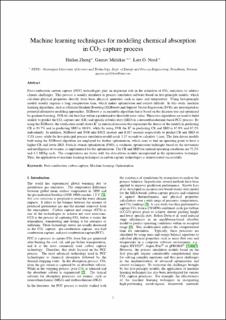| dc.contributor.author | Zheng, Huilan | |
| dc.contributor.author | Mirlekar, Gaurav | |
| dc.contributor.author | Nord, Lars O. | |
| dc.date.accessioned | 2023-01-31T13:15:59Z | |
| dc.date.available | 2023-01-31T13:15:59Z | |
| dc.date.created | 2022-11-01T10:39:18Z | |
| dc.date.issued | 2022 | |
| dc.identifier.isbn | 978-91-7929-545-5 | |
| dc.identifier.uri | https://hdl.handle.net/11250/3047451 | |
| dc.description.abstract | Post-combustion carbon capture (PCC) technologies play an important role in the reduction of CO2 emissions to address climate challenges. This process is usually simulated in process simulation software based on first-principle models, which calculate physical properties directly from basic physical quantities such as mass and temperature. Using first-principle models usually requires a long computation time, which makes optimization and control difficult. In this study, machine learning algorithms, such as eXtreme Gradient Boosting (XGBoost) and Support Vector Regression (SVR), are investigated as potential alternative modeling approaches. XGBoost is an ensemble algorithm that is based on the decision tree and optimized by gradient boosting. SVR fits the best line within a predefined or threshold error value. These two algorithms are used to build models to predict the CO2 capture rate (CR) and specific reboiler duty (SRD) in a monoethanolamine-based PCC process. By using the XGBoost, the verification result shows R2 (a statistical measure that represents the fitness of the model) in predicting CR is 91.7% and in predicting SRD is 80.8%, while by using SVR the R2 in predicting CR and SRD is 87.9% and 87.2% individually. In addition, XGBoost and SVR take 0.022 seconds and 0.317 seconds respectively to predict CR and SRD of 1318 cases, while the first-principal process simulation model needs 3.15 seconds to calculate 1 case. The data-driven models built using the XGBoost algorithm are employed for further optimization, which aims to find an operating point to have a higher CR and lower SRD. Particle swarm optimization (PSO), a stochastic optimization technique based on the movement and intelligence of swarms, is implemented for the optimization. The CR and SRD for optimal operating conditions are 72.2% and 4.3 MJ/kg each. The computations are faster with the data-driven models incorporated in the optimization technique. Thus, the application of machine learning techniques in carbon capture technologies is demonstrated successfully. | en_US |
| dc.language.iso | eng | en_US |
| dc.publisher | Linköping University Electronic Press | en_US |
| dc.relation.ispartof | Proceedings of the 63rd International Conference of Scandinavian Simulation Society, SIMS 2022, Trondheim, Norway, September 20-21, 2022 | |
| dc.rights | Navngivelse 4.0 Internasjonal | * |
| dc.rights.uri | http://creativecommons.org/licenses/by/4.0/deed.no | * |
| dc.title | Machine learning techniques for modeling chemical absorption in CO2 capture process | en_US |
| dc.title.alternative | Machine learning techniques for modeling chemical absorption in CO2 capture process | en_US |
| dc.type | Chapter | en_US |
| dc.description.version | publishedVersion | en_US |
| dc.source.pagenumber | 72-79 | en_US |
| dc.identifier.doi | 10.3384/ecp192011 | |
| dc.identifier.cristin | 2067219 | |
| cristin.ispublished | true | |
| cristin.fulltext | original | |
| cristin.qualitycode | 1 | |

